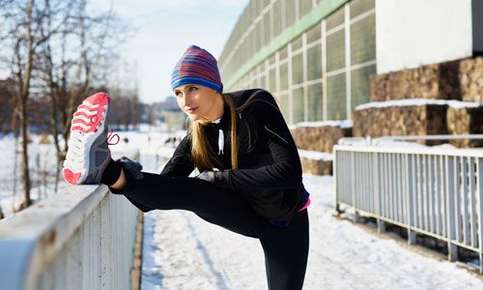
The onset of winter does not signal the end of exercise and outdoors activities. There's plenty of skiing and snowboarding available in the Northeast, the American Rockies, across Canada, and even in Southern California. For those who like their exercise with less dramatic velocity and acceleration, walking and running continue to be possible in winter. The key to successful exercise throughout the winter, beyond the will power required to just get out there and do it, is an extra level of care and attention to what's going on around us and directly in front of us.
In the urban environment, the primary problem from late November through March is slippery sidewalks and roads. If you're not cautious, you might step on a hidden patch of ice and end up on the ground. This is true even in Southern states such as Georgia, Louisiana, and Texas, where winter snowstorms are not uncommon. If you're exercising outdoors and have some momentum going, a slip and fall may have serious consequences including strains, sprains, and fractures.1
The first step in preparing for these winter challenges is appropriate footgear. Old walking or running shoes that have lost most of their tread should be avoided.2 Your footgear should fit comfortably and be able to accommodate thicker socks without being tight and constricting.
The next step is to create additional input and stimulation to your body's proprioceptive system, which is made up of specialized nerve endings that give you awareness of your position in three-dimensional space. Enhanced function here leads to improved agility and balance.3 One way to augment this system is to put a bend in your knees when you expect to encounter slippery surfaces. The increased knee flexion provides for a greater range of musculoskeletal responses to sudden changes in the environment, in this case, the ground you're walking or running on.
A third step is to raise your level of awareness. You might be firm and sure on your legs but others may not be so steady. Pedestrians or runners may slide into you, as may bicyclists and skateboarders. It's especially important when crossing intersections to be aware of automobiles and trucks which may not brake as expected and represent substantial dangers.
Finally, be sure you are keeping up with your regular chiropractic care. By detecting and correcting spinal misalignments, regular chiropractic care helps make your nerve system much smarter. When your nerve system is working at optimal capacity, all your body's systems are able to respond rapidly to changes in the environment. For example, with such peak function, if you start to slip or slide in wintry conditions your ankles, knees, hips, and low back all respond quickly to help prevent a fall. By assisting our bodies to become smarter, regular chiropractic care helps us enjoy a safe and fun-filled winter season.
1. Gianoudis J, et al: Effects of a targeted multimodal exercise program incorporating high-speed power training on falls and fracture risk factors in older adults: a community-based randomized controlled trial. J Bone Miner Res 29(1):182-191, 2014
2. Hsu J, et al: Slip resistance of winter footwear on snow and ice measured using maximum achievable incline. Ergonomics 59(5):717-728, 2016
3. Halvarsson A, et al: "Better safe than sorry": a qualitative content analysis of participant's perspectives of fall-related concerns and balance in older women with osteoporosis after balance training. Disabil Rehabil 3:1-7, 2015
